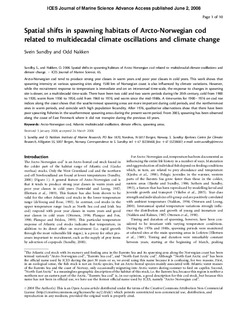| dc.description.abstract | Arcto-Norwegian cod tend to produce strong year classes in warm years and poor year classes in cold years. This work shows that
spawning intensity at various spawning sites along 1500 km of Norwegian coast is also influenced by climate variations. However,
while the recruitment response to temperature is immediate and on an interannual time-scale, the response to changes in spawning
site is slower, on a multidecadal time-scale. There have been two cold and two warm periods during the 20th century, cold from 1900
to 1920, warm from 1930 to 1950, cold from 1960 to 1970, and warm since the mid-1980s. A time-series for 1900–1976 on cod roe
indices along the coast shows that the southernmost spawning areas are more important during cold periods, and the northernmost
ones in warm periods, and coincide with high population fecundity. After 1976, qualitative observations show that there have been
poor spawning fisheries in the southernmost spawning areas during the present warm period. From 2003, spawning has been observed
along the coast of East Finnmark where it did not transpire during the previous 40 years. | en |
